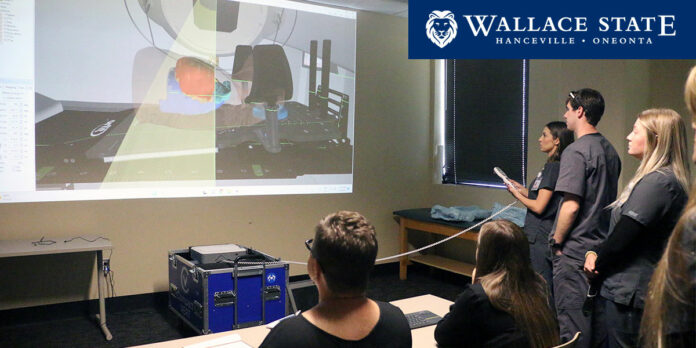HANCEVILLE — Wallace State students are benefitting from a tool that will help them in their careers as radiation therapists.
The school’s Diagnostic Imaging program introduced the Radiation Therapy option last fall, and students were provided with the Virtual Environment for Radiation Therapy (VERT) simulator. With the simulator, the students will can learn hands-on about the machines they will control in clinical training and treatments.
“This VERT provides an invaluable tool for the students,” said Leesa Cordell, instructor for the Radiation Therapy program.
Before the VERT’s arrival, students would not be introduced to the equipment until they were in the clinical setting.
“Now we have the VERT, and they actually get hands-on inside the lab in the radiation therapy classroom,” Cordell said. “It makes it safer for them, safer for the patients, and it makes patient through-put quicker for the clinical sites, because the students already have experience holding on to the pendant and working with that machine.
“The more comfortable they are when they get there, then the more confident they are, and the patients really pick up on that. If you’re not comfortable in the room with a patient, they sense it first.”
The VERT provides the student with 3-D imagery of the treatment room and the machine they use to administer external radiation treatments to cancer patients.
“The student can [virtually] walk in, get the hand pendant that we use with the machine in the room, and they can actually rotate [the machine] around a patient that is simulated on the table,” Cordell said.
The simulations cover different patients and types of cancers and are loaded with specific treatments for each scenario.
“We can look at the beams, we can look at internal organs over the patient, we can even place MRIs or CAT scans that are actual treatment plans and look at those while the patient is on the table,” Cordell said.
The beams that show where radiation is delivered can be charted, showing the exact amount of radiation delivered to a certain part of the patient’s body.
And just like in the machines they will use in clinics alarms will sound for technicians if the parameters set are not correct or if the machinery gets too close to the patient.
Student Madison Tidmore is grateful she had the opportunity to use the VERT before going to clinicals and as a refresher after holiday breaks.
“It’s very in depth, so to be able to have that knowledge before you go into clinic, it definitely ties everything together,” she said. “This actually gives us that confidence to go into that room and pick up that pendant and actually move the patient and align them on the first try.
“I think it definitely builds confidence.”
Along with the associate degree in Radiation Therapy, the Diagnostic Imaging program offers its traditional associate degree in Diagnostic Imaging, preparing students to work as radiologic technologists, with cross-training for CT scans, MRIs, mammography and cardiac intervention. Both are four semester programs with two semesters of prerequisites to be completed before applying.
Applications for entry this fall are being accepted through June 1. Visit www.wallacestate.edu/Diagnostic-Imaging; or contact Mindie Sandlin at 256-352-8334 or [email protected].
Registration for summer and fall semesters is underway. Summer classes began May 24; mini term II starts June 30 and fall classes begin Aug. 18.
For more information, visit www.wallacestate.edu, call 256-352-8000 or come by Lion Central in the lobby of the James C. Bailey Center Monday-Wednesday 7:30 a.m. to 6 p.m., Thursday 7:30 a.m. to 4:30 p.m., or Friday 7:30 a.m. to 2 p.m.
Don’t miss out! Subscribe to our email newsletter to have all our smart stories delivered to your inbox.



